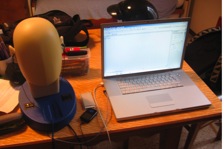


What MP3 Players Do to Teenagers
Adriano Farina
Liceo Classico G.D. Romagnosi, Parma, Italy
Popular version of paper 3pPPb3
"Assessment of hearing damage when listening to music through a personal digital audio player"
Presented at 2:40 p.m. on Wednesday July, 2, 2008 in Room 242A
Overview
This study aims to assess the potential hearing damage induced by personal mp3 players in teenagers, who are exposed to high levels of sound due both to listening habits and to noisy background. The potential riskiness of portable music players is debated since the introduction of the first Walkman, but players are getting longer battery lives with each generation, thus increasing the potential daily exposition. Additionally, the earphones included with recent players provide little insulation for external noise, but still are quite powerful.
Several existing studies have assessed the maximum output possible for the most popular devices, and legislation only considered this factor. Instead, we tried to get an impression of the average listening levels to which teenagers are exposed in real life.
My schoolmates were used as subjects.
Method
In order to achieve a statistically relevant result we averaged the musical genre. We collected all the music present on the subjects’ players and we averaged its physical data (loudness and frequency). We obtained a test signal that depicts quite accurately the musical tastes of Italian teenagers of my area and age. (Music_mp3_192kbps.mp3) In addition to that we employed the standard test signal for loudness measurements in music players, defined by the IEC 50332 standard. (IEC_mp3_192kbps.mp3) We asked the subjects to give us their players with the volume set at the last usage.
We loaded the test signals on the player and we proceeded to measure the loudness of the sound emitted using a dummy head connected to a laptop computer.

Results
More than 70% of the subjects had volumes set to over 80 d.B. According to European legislation it is unsafe to be exposed to sounds 80 d.B. and higher for more than 8 hours. Most modern mp3 players’ battery lives are much longer than that, thus allowing users to get potentially unsafe levels of noise. As most players had even higher volumes, we tried to estimate what a safe listening time would have been for those levels. The results were astonishing, as almost 40% of the subjects had times below one hour, and the average daily listening time is about two hours.

Conclusions
However, a proper assessment of the real risk could only be done by monitoring for the whole day the noise exposure of the students, and taking into account also the other causes of high sound pressure levels which are part of the life of a teenager: videogames, motorcycles, cinema, discos, sports, etc… The data obtained in this preliminary work, indeed, suggest that the usage of personal audio players can contribute significantly to the daily noise dose, and can result, on the long term, in severe risk of hearing loss and of other noise-exposure induced illness. It appears necessary that these devices are designed and calibrated in such a way that they cannot generate such high sound pressure levels, and that more severe rules are enforced. We cannot wait 10 or 20 years, for later discovering that entire generations of the population are suffering of severe hearing problems due to over-exposition in their teen age. Hearing loss is already the prime cause of work-induced illness in Europe, causing unacceptable costs to the public health and insurance systems. A lot of money has been spent for reducing the noise at the workplace, but this will be wasted if we allow our youngsters to be over-exposed for years due to the usage of personal digital audio players capable of dangerous levels.
Further information is available through my website: http://www.adrianofarina.it